Audio-Technica ATW-2193BI Handleiding
Audio-Technica
Niet gecategoriseerd
ATW-2193BI
Bekijk gratis de handleiding van Audio-Technica ATW-2193BI (12 pagina’s), behorend tot de categorie Niet gecategoriseerd. Deze gids werd als nuttig beoordeeld door 67 mensen en kreeg gemiddeld 4.6 sterren uit 34 reviews. Heb je een vraag over Audio-Technica ATW-2193BI of wil je andere gebruikers van dit product iets vragen? Stel een vraag
Pagina 1/12

2000 Series
Frequency-agile True Diversity UHF Wireless System
Installation and Operation

2000 Series Installation and Operation
2
This device complies with part 15 of the FCC Rules. Operation is
subject to the condition that this device does not cause harmful
interference.
This device complies with INDUSTRY CANADA R.S.S. 210, en
conformité avec IC: RSS-210/CNR210. Operation is subject to the
following conditions: 1) This device may not cause harmful interference
and 2) this device must accept any interference received, including
interference which may cause undesired operation.
Hereby Audio-Technica declares that this device complies with the
essential requirements and other relevant provisions of the R&TTE
directive 1999/5/EC
FCC Notice
Caution
You are cautioned that any changes or modications not expressly
approved in this manual could void your authority to operate this
equipment.
Note: This equipment has been tested and found to comply with
the limits for a Class B digital device, pursuant to part 15 of the FCC
Rules. These limits are designed to provide reasonable protection
against harmful interference in a residential installation. This equipment
generates, uses and can radiate radio frequency energy and, if not
installed and used in accordance with the instructions, may cause
harmful interference to radio communications. However, there is no
guarantee that interference will not occur in a particular installation. If
this equipment does cause harmful interference to radio or television
reception, which can be determined by turning the equipment off and
on, the user is encouraged to try to correct the interference by one or
more of the following measures:
- Reorient or relocate the receiving antenna.
- Increase the separation between the equipment and receiver.
- Connect the equipment into an outlet on a circuit different from
that to which the receiver is connected.
- Consult the dealer or an experienced radio/TV technician for help.
A copy of the user’s manual and DoC can be found at
www.audio-technica.com.
CAUTION! Electrical shock can result from removal of the receiver
cover. Refer servicing to qualied service personnel. No user-
serviceable parts inside.
• To prevent re or shock hazard, do not expose this appliance to rain
or moisture.
• To prevent re, do not place any naked ame sources (such as
lighted candles) on the apparatus.
• To prevent re, do not cover the ventilation of the apparatus with
newspaper, tablecloths, curtains etc.
• Do not expose this apparatus to drips or splashes.
• Do not place any objects lled with liquids, such as vases, on the
apparatus.
• Do not install this apparatus in a conned space such as a bookcase
or similar unit.
• The apparatus should be located close enough to the AC outlet
so that you can easily grasp the AC adapter at any time. In case of
emergency, disconnect the AC adapter quickly.
• Danger of explosion if battery is incorrectly replaced. Replace only
with the same or equivalent type.
• Always consider environmental issues and follow your local
regulations when disposing of batteries. Do not expose batteries
to excessive heat.
The circuits inside the receiver and transmitter have been precisely
adjusted for optimum performance and compliance with federal
regulations. Do not attempt to open the receiver or transmitter.
To do so will void the warranty, and may cause improper operation.
Notice to individuals with implanted cardiac pacemakers
or AICD devices:
Any source of RF (radio frequency) energy interfere with normal may
functioning of the implanted device. All wireless microphones have
low-power transmitters (less than 0.05 watts output) which are unlikely
to cause difculty, especially if they are at least a few inches away.
However, since a “body-pack” mic transmitter typically is placed against
the body, we suggest attaching it at the belt, rather than in a shirt
pocket where it may be immediately adjacent to the medical device.
Note also that any medical-device disruption will cease when the RF
transmitting source is turned off. Please contact your physician or
medical-device provider if you have any questions, or experience any
problems with the use of this or any other RF equipment.
RF Interference
Please note that wireless frequencies are shared with other radio
services. According to Federal Communications Commission
regulations, “Wireless microphone operations are unprotected
from interference from other licensed operations in the band. If any
interference is received by any Government or non Government
operation, the wireless microphone must cease operation...” If you
need assistance with operation or frequency selection, please contact
your dealer or Audio-Technica. Extensive wireless information also is
available at www.audio-technica.com.
Thank you for choosing an Audio-Technica professional wireless
system. You have joined thousands of other satised customers who
have chosen our products because of their quality, performance and
reliability. This Audio-Technica wireless microphone system is the
successful result of years of design and manufacturing experience.
Each 2000 Series wireless system provides a choice of 10 PLL
synthesized UHF frequencies in one of ve UHF frequency ranges,
available for exible performance in a wide variety of regions
worldwide:
Frequency Range
Band D 656.125 – 678.500 MHz
Band E 795.500 – 805.875 MHz
Band F 854.900 – 864.900 MHz
Band G 722.125 – 744.500 MHz
Band I 487.125 – 506.500 MHz
Band U 606.500 – 629.900 MHz
The band letter reference at the end of 2000 Series Stock Numbers
indicates what band system/component operates in. For simplicity,
model numbers used throughout this manual will reference only the
basic model number without the band indications.
Each wireless system includes a receiver and either a body-pack or
handheld transmitter. UniPak® body-pack transmitter systems include
accessory microphones for particular applications. All A-T Wireless
Essentials® microphones and cables, available separately, are pre-
terminated for use with any Audio-Technica 2000 Series wireless
system.
The ATW-R2100b receiver features true diversity reception. Two
antennas feed two completely independent RF sections on the same
frequency; automatic logic circuitry continuously compares and
selects the superior received signal, providing better sound quality and
reducing the possibility of interference and dropouts. The receiver also
offers a switchable output attenuator to reduce the level of the output
signal by 12 dB for exible use with a variety of system congurations.

2000 Series Installation and Operation
3
Switchable antenna power is also provided. Soft-touch controls provide
convenient access to selection of operating frequency and automatic
scanning, while an LCD information display provides constant
monitoring of system operation. The receiver is half-width for a standard
1U 19" rack mount; rack-mount adapters are included. Two receivers can
be mounted side by side, using an optional AT8630 joining-plate kit.
The versatile ATW-T210a UniPak
® body-pack transmitter has both
low- and high-impedance inputs plus a bias connection, for use
with dynamic and electret condenser microphones, as well as Hi-Z
instrument pickups. The UniPak
® transmitter also offers separate trim
controls for instrument and microphone, plus switchable high/low RF
power.
The ATW-T220a handheld dynamic microphone/transmitter features
the same element used in the PRO 41 dynamic handheld microphone
created for professional live-sound venues. It also offers switchable
high/low RF power. Both the ATW-T210a UniPak® and ATW-T220a
handheld transmitters also offer charging contacts so the units can be
placed in an optional recharging station for multi-transmitter charging.
For economical operation and wide availability, transmitters in the
2000 Series use two 1.5V AA alkaline batteries or rechargeable two AA
NiMH batteries for use with Audio-Technica’s ATW-CHG2 Recharging
Station. Both transmitters have battery condition indicators. 2000 Series
receivers feature a sophisticated Tone Lock™ tone squelch system that
opens the receiver’s audio output only when a 2000 Series transmitter
is detected, reducing the possibility of interference. As a result, 2000
Series transmitters and receivers must be used together and should not
be used with components from other Audio-Technica wireless systems,
or with those of other manufacturers.
Please note that in multiple-system applications there must be a
transmitter-receiver combination set to a separate channel (frequency)
for each input desired (only one transmitter for each receiver).
Because the wireless frequencies are within UHF TV frequency bands,
only certain channels (operating frequencies) may be useable in a
particular geographic area. The 10 channels (operating frequencies) per
band that are used in the 2000 Series have been selected for multi-
channel compatibility. Subject to frequency availability in a particular
geographic area, any of these 10 channels may be used together. The
operating frequencies that correspond to each of the 10 channels are
listed on page 10.
Receiver Installation
Location
For best operation the receiver should be at least 3 ft. (1 m) above the
ground and at least 3 ft. away from a wall or metal surface to minimize
reections. The transmitter should be at least 3 ft. from the receiver,
as shown in Figure A. Keep antennas away from noise sources such
as digital equipment, motors, automobiles and neon lights, as well as
away from large metal objects.
Fig. A
Output Connections
There are two audio outputs on the back panel: balanced and
unbalanced. Use shielded audio cable for the connection between the
receiver and the mixer. If the input of the mixer is a 1/4" jack, connect a
cable from the 1/4" unbalanced audio output on the back of the receiver
housing to the mixer. If the input of the mixer is an XLR-type input,
connect a cable from the balanced XLR-type audio output on the back
panel to the mixer. The two isolated audio outputs permit simultaneous
feeds to both unbalanced and balanced inputs. For example, both a
guitar amp and a mixer can be driven by the receiver.
Antennas
Attach the included pair of UHF antennas to the antenna input jacks.
The antennas are normally positioned in the shape of a “V” (both 45°
from vertical) for best reception.
Accessory antennas can be remotely located from the receiver.
However, due to signal loss in cables at UHF frequencies, use the
lowest-loss RF cables practical for any cable runs over 25 feet. RG8-
type is a good choice. Use only copper-shielded cable, not CATV-type
foil-shielded wire. Audio-Technica offers quality RF cables in four
lengths, as well as remote antennas; see audio-technica.com for a wide
selection of wireless system accessories.
Antenna Power
The antenna input jacks also can provide +12V DC output on their
center pins to power inline RF devices. A maximum of 60 mA can be
drawn from each of the jacks. While an accidental short-circuit will not
harm the internal 12V supply, make certain that an antenna cable shield
does not contact the center conductor. Antenna Power is selected by
a switch on the back of the ATW-R2100b Receiver. The unit is shipped
with the switch in the “off” position.
Note: the antennas included with the ATW-R2100b Receiver do
not require power. If you have an antenna system that requires power
(such as powered antennas or active combiners or splitters) switch the
Antenna Power switch to the “on” position.
Power Connections
Connect the included AC adapter to the DC power input on the back of
the receiver. Loop the small cord from the DC plug over the cord hook
above the jack, to keep the plug from being detached by an accidental
tug on the cord. Operation of the receiver is controlled by the front-
panel Power switch.
Product specificaties
| Merk: | Audio-Technica |
| Categorie: | Niet gecategoriseerd |
| Model: | ATW-2193BI |
Heb je hulp nodig?
Als je hulp nodig hebt met Audio-Technica ATW-2193BI stel dan hieronder een vraag en andere gebruikers zullen je antwoorden
Handleiding Niet gecategoriseerd Audio-Technica
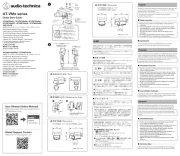
17 Juni 2025
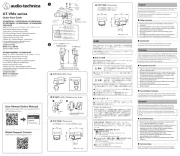
16 Juni 2025
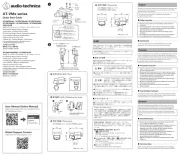
16 Juni 2025
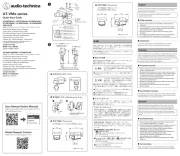
15 Juni 2025
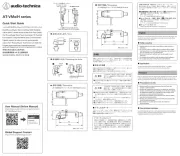
15 Juni 2025
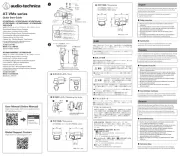
15 Juni 2025
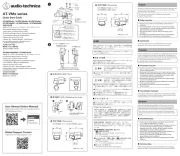
15 Juni 2025
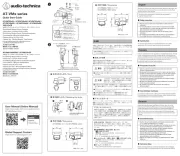
15 Juni 2025

15 Juni 2025
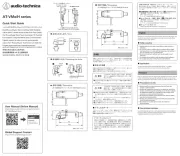
15 Juni 2025
Handleiding Niet gecategoriseerd
- Eufy
- Em-Trak
- Eligent
- Megableu
- Ashly
- Bullet
- Urbanista
- Korona
- Zenec
- Postium
- Heckler
- Princess
- Stanley
- Winter Modular
- Integral LED
Nieuwste handleidingen voor Niet gecategoriseerd

14 September 2025

14 September 2025

13 September 2025

13 September 2025

13 September 2025

13 September 2025

13 September 2025

13 September 2025

13 September 2025

13 September 2025